I have known Hiroki Kishimoto and Keita Hinamoto for a long time, so I was really excited when I heard they had teamed up to form a new brand: omotodenim. With many years of experience and connections behind them from their time at Japan Blue and Momotaro, respectively, I knew this was going to be something good.

And I was not wrong. From their gorgeous new store on Jeans Street in Kojima to their truly amazing products to their friendly service, omotodenim looks set to be a winner. I’ve been wearing my omotodenim jeans and chore coat for a few months now, and absolutely love both. Eminently comfortable, textured, and just a pleasure to wear.
I finally had a chance to sit down with both of them a while back in Kojima to discuss past, present, and future. Here is our conversation.
So how did you get interested in denim in the first place?
Kishimoto-san: Well, I always loved clothing back to when I was a student, and I was always checking out vintage clothing shops. So when I graduated from university, I was like, “What the heck should I do?” and I ended up talking to Manabe-san (founder of Japan Blue, Momotaro, and Collect Mills) who was running the fabric business, and I was like, “Whoa! Jobs like this exist?” So, it was from there that I started working in the industry, in the fabric side of things.
What year would this have been?
1998, when I entered Japan Blue.
Hinamoto-san, were you still in university at that time?
H: What? I was born in 1990, so…I was wearing a little kids’ backpack on my way to elementary school then (we all crack up).

Oh! Damn, my bad. You’re that young? Haha, I totally didn’t know that, sorry. But anyway, what’s your story for getting into the whole denim thing?
H: Well, almost unbelievably, I was born right near Ibara (Okayama). You’ve been there, you know, where Shinya Mills is. But right up until I was in university, I had no idea at all about denim, and certainly not that it was produced right in my area. Like, no idea. But then I went to university in China, and it was there that I met two friends: one from the States and one from Shiga in Japan and they had this amazing conversation about denim from Okayama. I was blown away, and it was only then that I realized that they were literally making some of the best denim in the world super close to my house. When I joined Japan Blue, a ‘sempai’ of Kishimoto-san’s taught me a lot about denim.
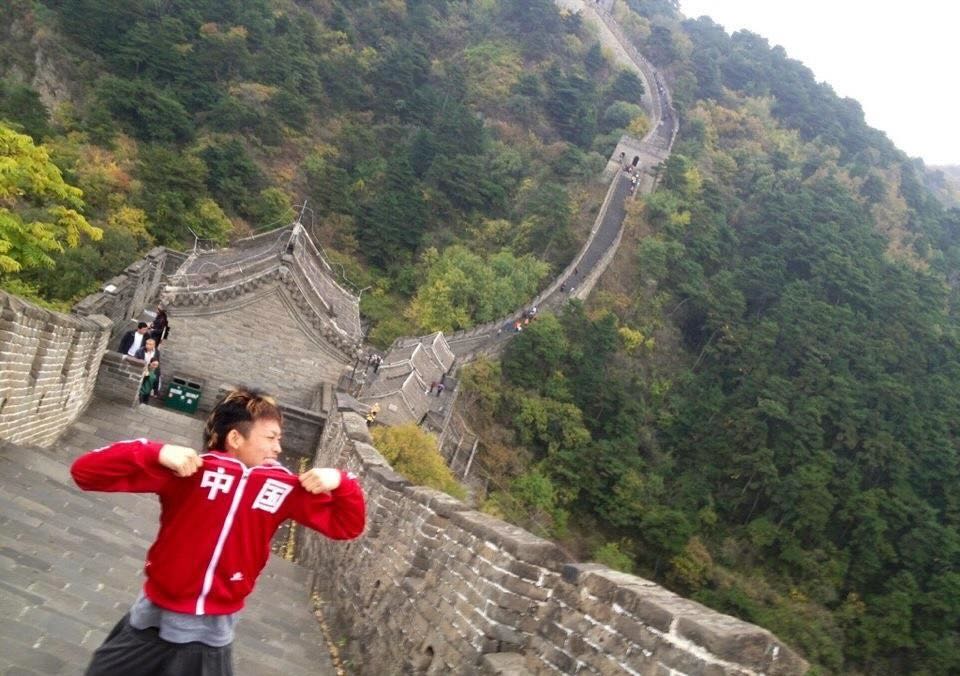
Kishimoto-san, are you also from Okayama?
K: I was born here, but then my parents were transferred elsewhere for work.
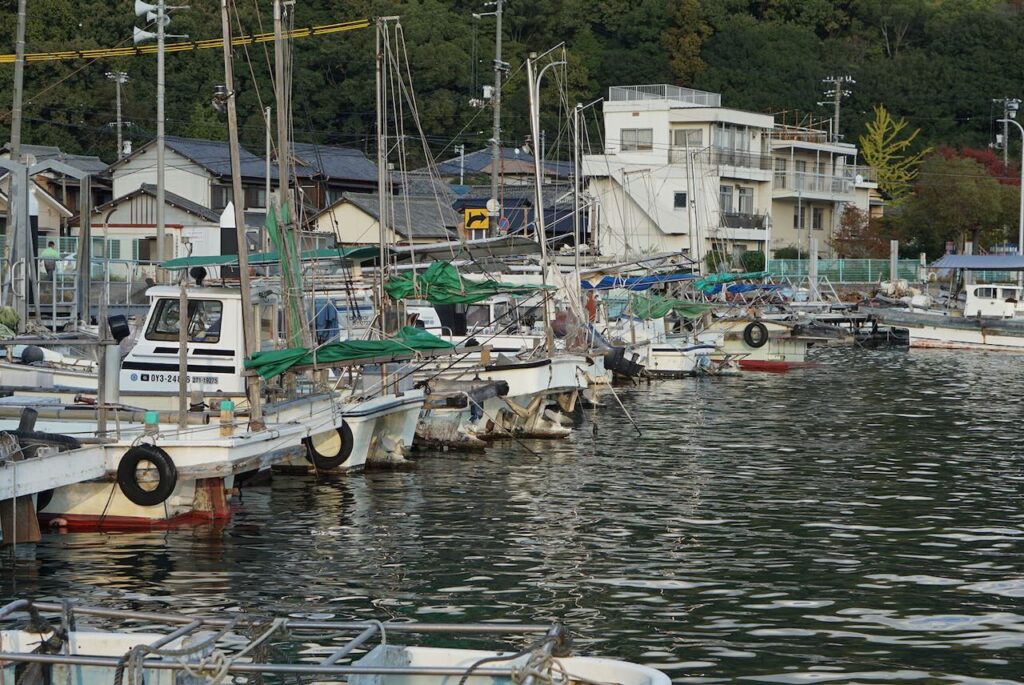
So you guys were buddies from the start?
H: I joined in 2015 and Kishimoto-san was already the business manager of Japan Blue at that time. But I worked on the Momotaro side, so we’d see each other at trade shows and stuff, mostly. So we worked together in a sense, but not like right beside each other.
How did you start your current brand, omotodenim?
K: Well, I had been preparing since last year, but we opened this March (2025). Of course, I made a lot of things at my previous job and gained a lot of experience from all those years of creating items for Japan Blue, but still, I wanted to make things on my own and kind of get a fresh start. I had always been really in love with Collect’s fabrics, so I wanted to use those while making things in a simpler style. So yes, it was really about making a clean, fresh start but using the skills and fabrics that I had learned and used previously.
So, you really liked, and like, Collect Mills’ fabrics? You still use them now?
K: Yes, even now.

I don’t know if I’m allowed to ask this, but are you still on good terms with your former employer?
Both: Yes, totally.
I think you told me once before, but what is the meaning of the word, “omoto”?
K: It’s a bit deep, but in Japanese we say ‘mannen’ which literally means 10,000 years, but also means things like ‘infinity’ or ‘evergreen’. These characters can also be read as ‘omoto’. So the idea is an evergreen tree that doesn’t fade or diminish. The meaning of ‘blue/green’ is in there, so yeah, like an everlasting green tree. I liked that meaning and also the word itself, so we went with that.
What’s the connection with the bird then on the logo?
K: The bird is connected with us sharing what we make here in Okayama out into the world, that sense of spreading out, moving over mountains.

Was anything tough back at the start?
K: Not really, to be honest. I was just continuing doing what I had always been doing, so in that sense, there was no huge learning curve like there would have been if I was a total beginner starting out. I also have a lot of connections, so there’s always a person that can help out with any kind of problem we might face.
I often hear that brands should cooperate more to support Okayama or Kojima as a whole, but instead there are a lot of feuds between brands. What do you think?
K: Well, those feuds might be overstated. While there are certain people or brands that have an issue with another brand, overall there’s a lot more getting along than not getting along. So generally, people and brands so support each other in spite of some personal differences that might exist.
What’s the very first item you guys made?
H: Jeans. Like the first pair that you picked up, the soft 13.5oz ones. Those, and also the 15.5oz ones which are a little stiffer and heavier. We’re also doing the neppy fabric now as well, like the chore jacket you like.

I’ll bet that neppy fabric is selling well already, especially with overseas buyers?
H: Well, yeah, we also thought that would be the case. When we were first planning a slubbier and neppier fabric, we figured it would be the overseas buyers that grabbed it all up, but surprisingly, it’s also been Japanese customers who have fallen in love with it. We didn’t really see that coming. There’s been a bit of general reversal on that actually over the past year or two, meaning that while it used to be that only non-Japanese went for the slubby and neppy fabrics, we really notice that it’s the Japanese customers who seem most into it. I think they also now realize how special it is, how unique it is, and they are also now starting to understand how few mills are now able or willing to make it. The places that can make it are decreasing.
Were you immediately satisfied with your first products?
K: Actually, yes. I know that most people might not say that, but again, I’m kind of continuing what I’ve been doing all along, with trusted partners all along the production journey, so although we are always making minor tweaks, generally speaking, we were very happy with the products from the start.

Have you guys noticed a huge uptick in the number of foreigners coming to Kojima? It’s crazy in Osaka and Kyoto, mostly I guess because of the low yen.
H: Not percentage-wise, actually. It’s still probably like 70% Japanese who come to Jeans Street, anyway.
Are you guys also selling online?
H: Yes. Probably about half domestically and then shipping about half of our sales overseas.
Tough balance, selling overseas from Japan while keeping overseas dealers happy.
K: Well, we make the sure the prices are about equal to avoid any advantage either way.
I’d like to talk about your actual store. I mean the physical building you made here on Jeans Street. It’s gorgeous…what was there before you built the store?
K: Nothing. It was just an empty piece of land. So we made that from scratch…took about a year?
How are you liking it?
K: Well, it’s great, but it gets full pretty quick. We don’t really have enough space to keep all of our stock full and organized, so….that part is a bit tough.
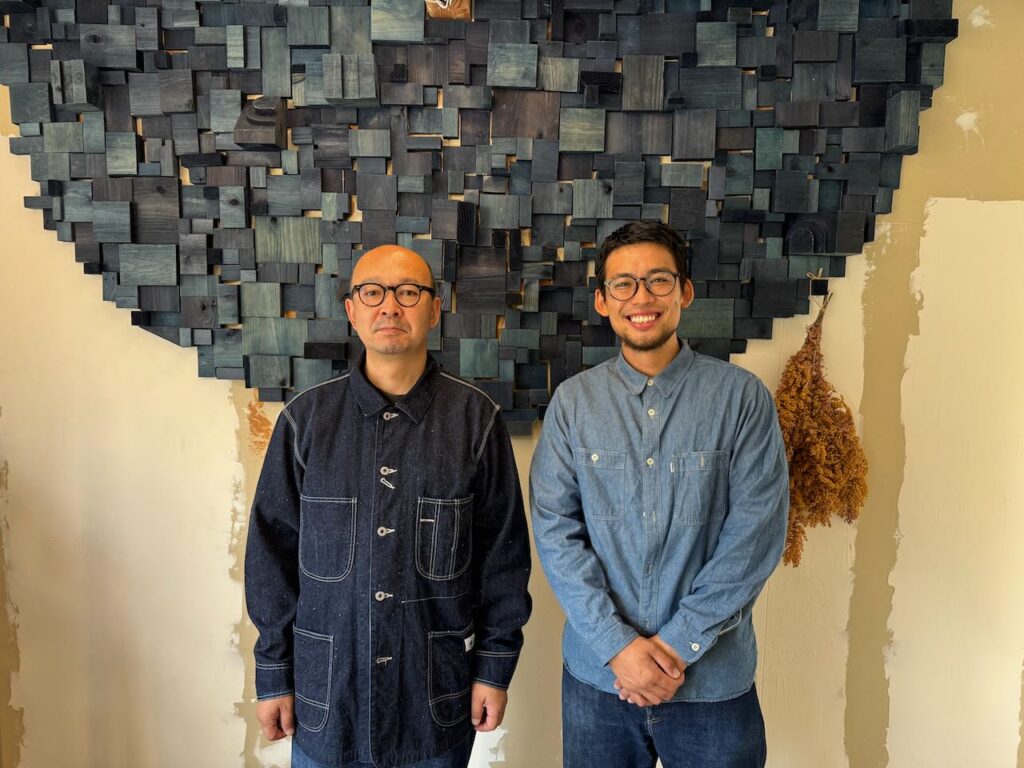
People always want to know what sets a certain brand apart from another. With so many choices these days, what do you see setting omotodenim apart from other, similar, brands?
K: Well, I think from one standpoint, the stuff we make might look a bit basic at first glance, but what’s ‘special’ about omotodenim doesn’t really become apparent until you wear it. The silhouette, the fabric. If these things aren’t perfect, you’re not going to want to wear your jeans all that much, so…I think we’ve done a pretty good job there. Admittedly, it’s hard to see what’s great or what’s different between brands just by looking at them sitting on a shelf.
H: I think that maybe compared to a lot of brands in Kojima or the brands that Dave visits who are of course using vintage Levis as a base, omotodenim has a bit more of a modern twist, especially when it comes to fit. I think we’ve been able to nail a kind of middle ground in terms of fit that’s been working well with both Japanese customers as well as those overseas. At our store and even at trade shows overseas, the thing we hear the most is a mildly surprised, “Whoa, these really fit well, especially in the top block.” For this reason, I’d ask people not just to pick up omotodenim jeans and hold them up to look at them, but please, please try them on. For real. Then you’ll know what we’re going on about.
Yeah, well I have a pretty strong feeling already even just from IG or talking to other customers and buyers that omotodenim has gotten popular super fast, like way faster than normally happens with a ‘new’ brand. I see people from all over the world, stores and end users, posting their omotodenim stuff.
H: Really? (laughs).
K: I’m happy to hear that.
Aside from the products being really good, is this because you already had all the connections and trust built up from your years in the industry? I mean, you were already a known quantity for so many shops and denim fans.
K: Well, not just me, but Hinamoto-san as well, so yes, we’ve kind of been able to hit the ground running with omotodenim.
H: I’d like to think it’s a combination of people already trusting and being comfortable with us along with the products themselves being really good. I think it’s both.

Are you guys doing a lot of shows overseas?
H: We went to the The Union showroom show in Germany and Tokyo.
Oh nice! I think Felix (founder of The Union) is coming over to Japan again soon.
H: Yes. We’re grateful to him for the help this time around, both here and overseas. He really helped us out.
Jumping back to fabric for a minute, I know you’re using Collect and Shinya. Is that also the case for the new neppy fabric?
K: Actually no, that’s made elsewhere.
I ask everyone this, but are you guys in any way worried about a shortage of selvedge denim in the future? Or more specifically, mills that can weave it, factories that can sew it, people who can fix all the machines. It’s no secret that everyone is getting older…
H: I don’t think we even need to go into the future for that to be an issue – it already is a problem right now. There is already a shortage of denim. The waits are getting longer for selvedge denim.
K: The people in those industries and in those areas are also worried, not just the brands. It’s this odd situation where there isn’t enough, and yet we also need to keep them filled with orders so that they can survive. As a brand, we need to work together with the denim mills and sewing factories, and that means keeping them full with orders as much as we are able. I know some places are bringing in younger people to learn the trade, but still…all we can do is try and keep giving them business.

And this extends to the sewing side of things obviously, not just the weaving?
K: Of course, yes. We’d like to have our own sewing factory, actually, but we haven’t go that worked out yet.
Do you find any differences between Japanese customers and customers from overseas?
H: Do you mean the ones that actually come to Kojima?
I guess so, yeah. I sometimes hear that Japanese customers are more interested strictly in the product itself where as a lot of overseas people are as much (or more) interested in the story behind the brand, the owner’s philosophy, etc.
K: That’s hard to answer. At the moment, the majority of customers who come in the store don’t know anything about omotodenim, and the interest kind of starts there, once they try the stuff on.
H: I know what you’re saying, Dave, but I think that things might have changed a bit. I also felt like maybe 5 years ago overseas customers always wanted to know the story behind things (how and why things were made) and Japanese customers didn’t care so much about that, but lately I feel that’s really changed. Now I think that Japanese customers are also getting really interested in the history or philosophy behind the clothes they are trying and buying.

That’s actually a great thing. Most of my Japanese friends are surprised to hear that jeans are even made in Japan, let alone the best jeans in the world! (laughs) I’m always hoping local people will get more interested in this amazing thing happening right in their own area.
H: We are seeing more and more Japanese people coming in super interested in how these things are being made and why. In many cases, it’s actually because they’ve heard that foreign people are super interested these days in this stuff that’s made in Japan…so while the order of things may be a bit weird, we’re kind of getting there in the end as far as domestic interest goes. Such a wild sequence though, isn’t it? America makes jeans way over a century ago, they eventually become popular in Japan, Japanese start to reproduce them to a level where they attract the attention of denim fans worldwide, and only then do most Japanese look and see that these jeans from their own country are being admired from afar and then they themselves become very interested. Fascinating, right?
It totally is. Continuing from that, how do you feel Jeans Street is doing overall? Is it getting busier than before? To me, it seems busier than before, but I’m only down here every few months, so…
K: Hmmm, well aside from the obvious Covid dip, I actually feel a bit of a downward trend as far as overall numbers go.
H: Taking a positive slant here, while the overall number of people might be a bit less, I think the number of interested young people has actually increased, and this is obviously a positive thing.
I wish there was more we could do to get more people to come and see how awesome Kojima is. A lot of people contact me before they come to Japan during the planning stage, and a common theme is that the guy totally wants to spend the day in Kojima, whereas maybe his partner isn’t so keen…I guess the image being that there’s nothing to do here except buy jeans. I think they need a nice, cheap hotel here too.
K: There actually are some “minpaku” around now. (Minpaku is like a B&B or private residence that takes lodgers). Some cool new cafes opening up as well which has helped.

Switching it up again here – Kishimoto-san, how would you describe yourself? What’s your personality?
H: Whoa! That’s hard. I’m not so serious, to be honest. I’m kind of the type who doesn’t like to keep doing the same thing over and over. I guess that’s good and bad, but I often get really into something, build it up, and then want to move to the next challenge. I’m absolutely grateful to be able to enjoy a fresh start and a new challenge all within the industry that I love.
K: What am I like? I wonder. At least, I can say that I am pretty serious. I also like to do things that others aren’t doing, but I am fairly serious about it. If I had to dedicate myself to one thing, it’s definitely denim. It’s been my life’s work, and even after all these years, I am still finding new and exciting things about it. I honestly just feel grateful – it’s been a real blessing to have found my calling in something so special.

So, you guys get along well then, considering your personalities?
H: (laughs) Yeah, we totally get along. He kind of reins me in when I’m like, “Let’s make this! And this! And then this!” He’s like, “Take it easy, let’s focus on what we’re doing for the moment.” (laughs)
What does a normal day look like for you guys? Are you mostly in the shop during the week?
K: I’m of course doing customer service in the store, but I also need time to take care of the production end of things. I need to be talking with the denim mills and the sewing factories pretty regularly as well. That might actually be the larger part of my job.
H: I’m in the store, but I’m also doing all the overseas communication and transactions. Also running the online shop.
What’s the best and worst parts about your jobs?
H: I don’t have any really ‘bad’ parts to report yet.
K: Me neither, actually.
H: As for the best parts, for me, it’s when a customer comes in knowing nothing at all about the brand, ends up trying it on and buying it with a huge smile…that’s the best feeling for sure. It’s been fun to use all of the skills I built up over the past decade, but with a new brand right from the brand’s beginnings. Watching it grow and taking part in all of that has been great.
K: Ah, actually I did think of one thing that can be a bummer: when the production doesn’t come out perfectly, and they become “B-level” products. I mean all of that work went in to something that comes our imperfect and can’t be sold as a normal product. That sucks, for sure.
What I love is the opposite of that. When all the planning, all the discussions with the factories, comes to a perfect ending and the product you envisioned is really right there in front of you, perfect and just how you wanted it. That’s the best.

What do you guys like aside from work? I mean, what are your hobbies?
K: Denim (we all crack up)
I kind thought you would say that.
K: But actually, I like old cars. Fixing them up.
What kind of cars?
K: Autobianchi. (Autobianchi was an Italian car maker from 1955 – 1955)

I love old cars too, but I have never heard of that brand.
K: I’ve had an old one for about 10 years, but just recently I’ve decided to fix it up and restore it. (Kishimoto-san shows us a picture of his cool little red car). Mine is a 1985.

Hinamoto-san, as a fairly new dad, your hobby must be your child?
H: Yeah, of course. But, as you know, I love the New York Knicks. NBA. I was born in Okayama, but I think I’ve got blue and orange running through my veins.
How do you want omotodenim to grow and develop in the future?
K: More than just my own brand, I really want to support Kojima as a whole. There is so much history and talent here, so me trying hard with this brand has the larger goal of revitalizing this area. I’m always thinking of other things I can do as well to support our local area.

Some people feel that we are in a kind of second denim boom at the moment here in Japan. Of course, there was the big one in the 90s when the J-denim repro brands exploded, but there seems to be another upturn over the past few years. Have you noticed that? Or is it just that the low yen has brought more people to Japan recently and what might feel like a boom in sales is just incidental to the larger tourist boom?
H: No, I do think there is another boom happening recently with selvedge denim.

How is the low yen for you guys? Good or bad?
K: Totally both. Raw materials are more expensive, but finished products might be cheaper to buy for other countries or currencies compared to the yen. So production costs have risen while sales have also risen.
H: It’s tough.
Kyoto and Osaka are absolutely packed with tourists these days, maybe partly due to the low yen.
K: We haven’t really felt that too much in Okayama yet.
How do you guys handle repairs?
K: We’re working on setting up that capability now. We aren’t doing it yet.
Will it be free?
K: We are still trying to work all that out, but probably not free. I’m thinking of cool ways we can do repairs to make them look awesome and unique.
Like sashiko or something?
K: Yeah! Like those kind of ideas…
What is your current return policy?
H: Customers have a week to let us know if they want to return something, as long as the item is still in perfect condition. But actually, we haven’t even had a single return request yet.
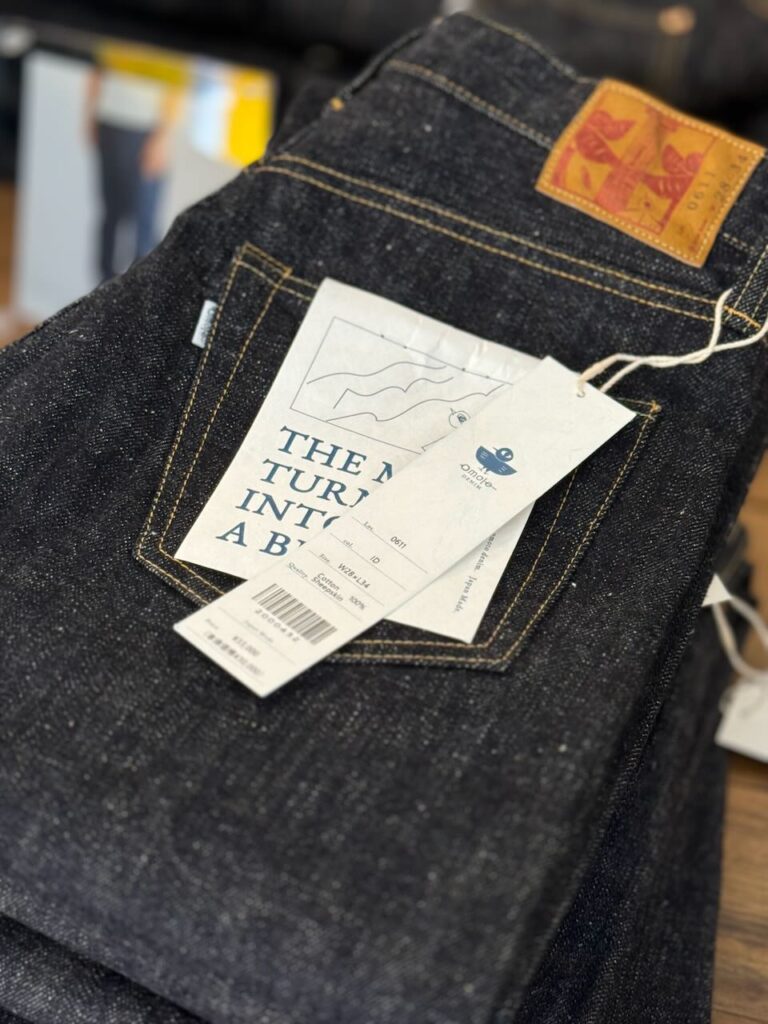
Wow. Are your measurements all clearly posted on the web shop?
H: Yes, they are there.
Are there any cool items that are upcoming or that you’d love to make in the future?
K: Well, I’d actually like to dig deeper and make tweaks to the jeans we already have as well as do some special editions of existing models.
Hinamoto-san?
H: I’d like to make some items that represent certain traditional production areas in Japan. Like, Wakayama is famous for sweatshirt and T-shirt material, Nishiwaki is famous for flannel, etc. I’d like to make some stuff using these amazing, traditional local fabrics. So, people will know that there’s more than just amazing denim made here in Japan. Local people and people overseas. That would be awesome.
Do the designs come from you, Kishimoto-san, or both of you?
K: Both of us.
And how many people ‘is’ omotodenim at the moment?
K: Just three of us.
How did you come up with the ‘recipe’ for your current denim?
K: Well, it’s based on my 30 years already in the industry but also planning with the fabric guys incorporating tweaks like ease of wear or other parameters that we want to adjust.
I probably already know the answer, but are you planning on making any heavier denim than you are already producing?
K: Hahah, yeah not really. I already think that 15.5 is ‘heavy’. As comfort is the main thing for us, I don’t really see any need to go heavier than we are currently.

And I know some people want to know stuff like this, but where is your cotton actually from?
H: For our standard denim, the warp is American, Memphis, while the warp is Zimbabwean cotton. For the 15.5. it’s a mix of Texas and Zimbabwe. The slubby/neppy is a mix of Australian and American cotton.
Do you have a favorite item you’ve made so far?
K: For me, our greatest achievement is the 13.5oz denim. I think we really nailed that one.
H: I kind of feel the same, but it’s probably boring for an interview if I say that, so….(laughs) I also love the slubby stuff we make! (we all laugh). But honestly, I love both of those fabrics.
Any new stuff in the pipeline?
K: Yes, we actually have a new sashiko fabric coming out in ’26. Probably for a jacket and pants set up. It should be good.
H: But more than trying to make new and different items every season, we really aiming to keep our core items strong and just add other items slowly along the way. If you have something good, you should keep doing it. We also want to keep our partners in the mills and factories going as well, so that’s another reason to keep making the same things every year.

How do you guys handle ‘western sizing’? Each brand approaches that a bit differently.
H: I think our stuff works well for non-Japanese as well. Even our shirts like this chambray I’m wearing seem to fit what might be called a ‘western’ body shape. I used to hear things like “The sleeves are too short” or “The body isn’t long enough” before when I was overseas with my prior job, but I haven’t heard that yet at all with omotodenim, so…that’s a good thing. We’re also kind of a relaxed style to begin with, so even guys with a big chest or something seem to fit our shirts okay.
K: The younger generation of Japanese people, like in their 20s and 30s, are also pretty ‘big’ and not that far off western sizes. We have a lot of young people buying omotodenim in Japan, and a lot of them have just as long arms or bodies as a lot of non-Japanese do, so that difference isn’t what it was, it seems, at least with younger people.
Do you guys have a list of places outside of Japan that stock omotodenim?
H: Yes, for sure, on our homepage.
Great. That’s one of the first questions I get: “Nice interview, but where can I buy it?” (laughs) This has been a great chat, by the way. I’ve known you for a long time, so it’s so awesome to see this great new brand and how well everything is going. Thanks for your time.
K and H: Thank you, too. Looking forward to seeing the interview in print.
I’ll do my best!


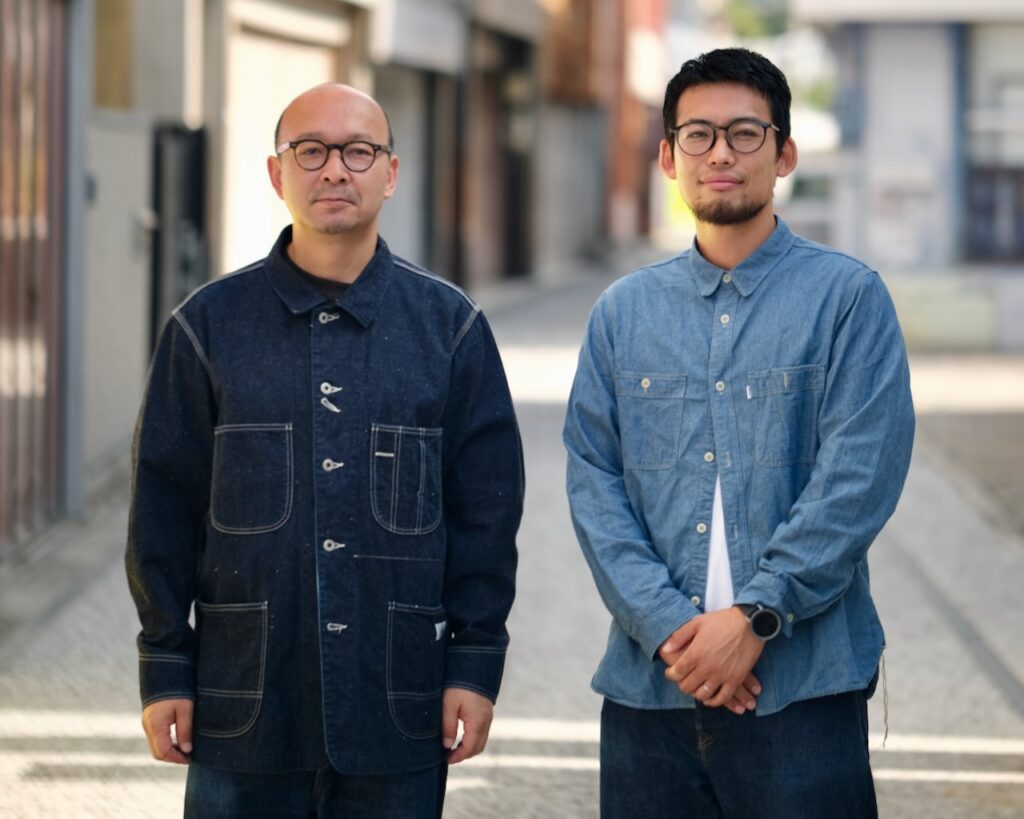
Man! Such a good read!!! My pair of Omoto are easily some of the most comfy jeans I own!!! I also have a tote bag that I use EVERY DAY! This interview was sooo good! Thanks to all of you for sharing!!